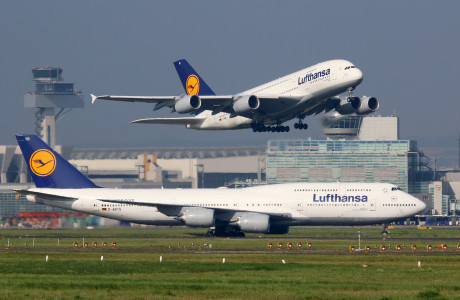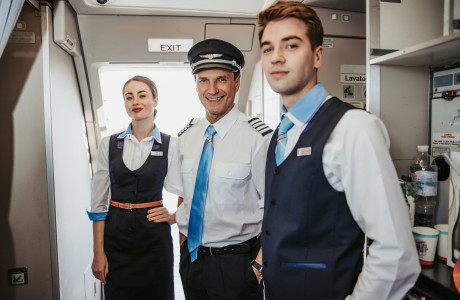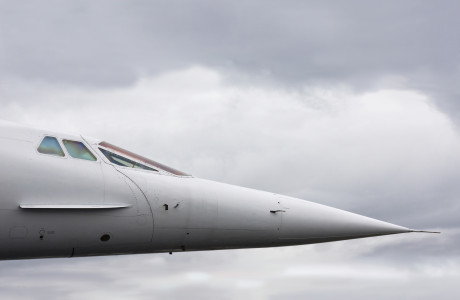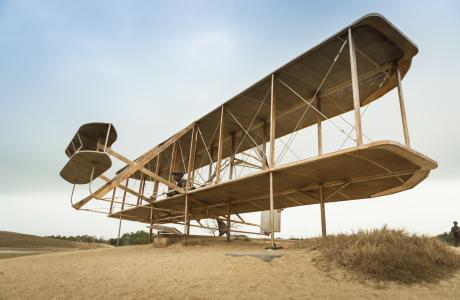
The Wright Brothers & the Modern Airplane
The Wright brothers, Wilbur and Orville, are often credited as the inventors of modern aviation. Their aircraft, known as the Wright Flyer, are considered the first fully functional airplanes. But how did the Wright brothers come to their invention? What technical features led to the success of their machines? Who was involved or even ahead of the brothers? And what do bicycles have to do with modern airplanes? The answers can be found in the following article.
Contents
The Path to Invention by the Wright Brothers
As two of seven children in a middle-class family in the American Midwest, the Wright brothers were not necessarily destined for their later career. Their journey to becoming leading aviation pioneers can be traced step by step:
1889-1896: Beginnings in Mechanics
The Wright brothers' interest in mechanics was initially sparked by printing presses. Although their attempt to publish their own newspaper was unsuccessful, the rise of the modern bicycle created a significant demand, which they capitalized on by opening a bicycle shop in 1892. Four years later, they began manufacturing bicycles under their own brand.
1897-1899: Influence by Otto Lilienthal
After opening their bicycle shop, Wilbur Wright, the more inventive of the two, became increasingly interested in the German aviation pioneer Otto Lilienthal. After Lilienthal's fatal accident during a test flight with a glider in 1896, the Wright brothers seriously began exploring mechanical concepts for aviation. They identified the control of the aircraft as crucial to solving the "flight problem," as they already deemed engines and wings promising.
1900-1902: Flight Experiments
Like Otto Lilienthal, the Wright brothers initially focused on gliding to determine the correct control techniques. For their first experiments, Wilbur and Orville went to what is now Kill Devil Hills in the summer of 1900. While their sister Katherine oversaw the bicycle shop, the brothers returned for more experiments over the next few years. With the help of their mechanic, Charlie Taylor, they began work on the Wright Flyer I.
The Wright Flyers
After three years of testing with gliders, Wilbur and Orville decided to attempt a motorized flying machine. In 1903, the Wright brothers built their first airplane, the Wright Flyer I. Subsequent models followed, but the basic production principles remained the same.
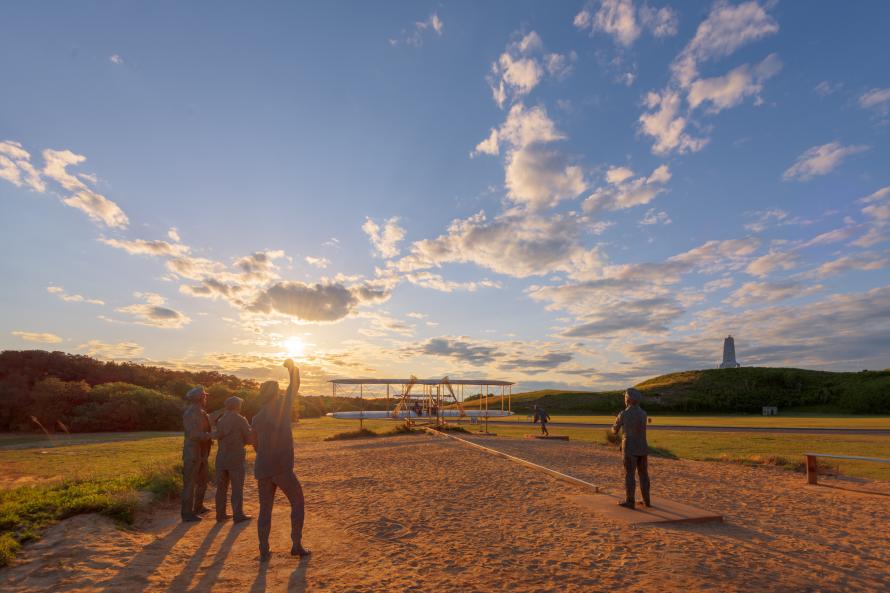
Engine
Unable to find suitable engines for their prototype, the Wright brothers had their mechanic from the bicycle shop develop one. Charlie Taylor designed and built a four-cylinder engine in six weeks, exceeding the required power output with 8.9 kW instead of the anticipated 6 kW.Structure
The Wright Flyer models were biplanes with the pilot lying on the lower wing. The engine powered two pusher propellers. The Wright Flyer's frame was made of spruce wood, while the wings were covered with a thin cotton fabric. The aircraft measured 2.74 m in height, 6.43 m in length, with a wingspan of 12.29 m, and weighed 274 kg.Control
The Wright brothers' crucial innovation lay in their understanding of control. They drew inspiration from observing birds and their experience with bicycles. While others tried to steer flying machines like ships or cars, the Wright brothers chose a method where the aircraft itself was tilted and then brought back into position using rudders, similar to how birds and bicycles navigate turns — a method still used by airplanes today.
A pivotal invention was the movable, vertical tail rudder, enabling the Wrights to control all three axes of flight (pitch, roll, and yaw). This was a crucial innovation that made modern airplanes possible.
By the way: While technology has advanced, the basic principle of airplanes has remained quite similar. Find out more in our article "Why Do Airplanes Fly?" to learn exactly how they work.
The Wright Brothers' First Flights
The first test flight with the Wright Flyer I took place on December 14, 1903, exactly 121 years after the Montgolfier brothers' first hot air balloon test. However, this was only a short, sputtering takeoff. The first controlled flight, covering 37 m in 12 seconds, was undertaken by Orville Wright on December 17. Three more flights were conducted that day, with the longest reaching about 260 m at an altitude of around 3 m.
The Wright Flyer I would never fly again, as it was heavily damaged by a gust of wind after the fourth flight. Although the Wright brothers had witnesses to their first flight, their success initially went largely unnoticed due to the relatively short distances.
Recognition & Controversies of the Wright Brothers
In the following years, the brothers improved their design and flight techniques. Despite initial skepticism and occasional setbacks, they became recognized as leading aviation pioneers by the end of the decade, securing contracts with the U.S. Army and touring Europe. By 1910, Wilbur, Orville, and their sister Katherine were among the most popular figures in the world.
However, they also faced legal battles over patents, and the Wright Flyer technology was soon surpassed by government-backed advancements, especially in Europe. Wilbur Wright died in 1912, and Orville conducted his last flight in 1918 but remained involved in aviation until his death in 1948.
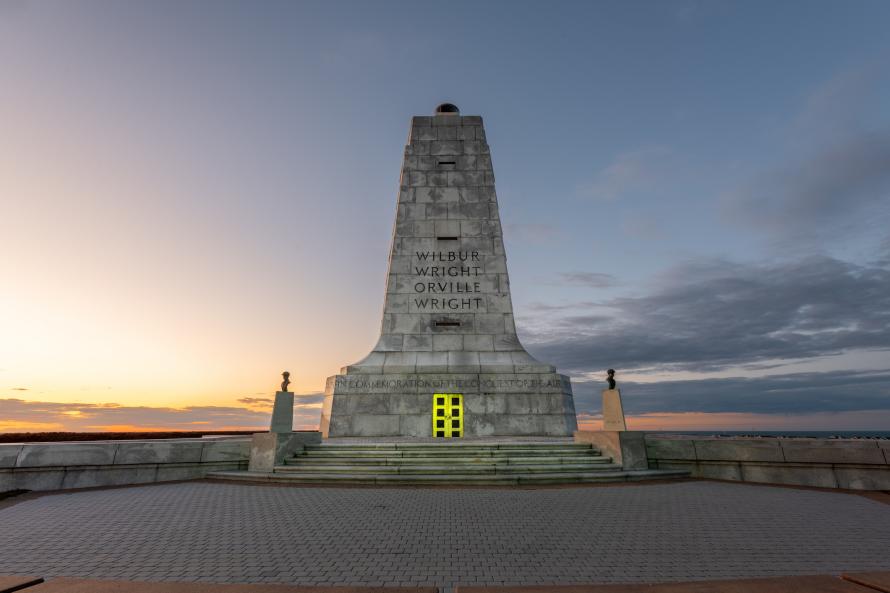
Throughout their lives and beyond, others have been suggested to have preceded the Wright brothers in their innovations, including:
Gustave Whitehead
Born as Gustav Weisskopf in Bavaria, the emigrant to the USA is claimed to have achieved a controlled powered flight in 1901. While some aviation experts have supported this claim over the decades, there is no conclusive proof that Whitehead actually flew.Alberto Santos-Dumont
The Brazilian aviation pioneer Alberto Santos-Dumont is less controversial, having flown his machine in France in October 1906. This flight is recognized as the first European flight. The controversy with the Wright brothers arises from their use of a rail and later a catapult device to take off, leading Santos-Dumont's defenders to credit him with the invention of the modern airplane.Others
In the early years, other names like Samuel Langley, a Smithsonian Institution chairman, and Clément Ader, a French pioneer, were also mentioned. However, these claims have been largely discredited or lack substantial support, often involving brief, uncontrolled lifts.
Thus, there is no clear case of others definitively preceding the Wright brothers. While they benefited from the work of predecessors like Otto Lilienthal, they introduced crucial new innovations. The Wright brothers can indeed be considered the first to have developed and flown an airplane by modern standards.
Following the Wright brothers, other pioneers like Howard Hughes further advanced aviation, enabling today's comfortable air travel at 10,000 m altitude. We wish you a pleasant flight.

